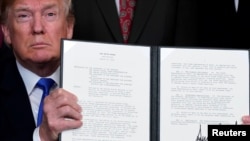THE WHITE HOUSE
Office of the Press Secretary
FOR IMMEDIATE RELEASE
March 22, 2018
MEMORANDUM FOR THE SECRETARY OF THE TREASURY
THE UNITED STATES TRADE REPRESENTATIVE
THE SENIOR ADVISOR FOR POLICY
THE ASSISTANT TO THE PRESIDENT FOR ECONOMIC
POLICY
THE ASSISTANT TO THE PRESIDENT FOR NATIONAL
SECURITY AFFAIRS
THE ASSISTANT TO THE PRESIDENT FOR HOMELAND
SECURITY AND COUNTERTERRORISM
SUBJECT: Actions by the United States Related to the Section 301 Investigation of China's Laws, Policies, Practices, or Actions Related to Technology Transfer, Intellectual Property, and Innovation
On August 14, 2017, I directed the United States Trade Representative (Trade Representative) to determine whether to investigate China's laws, policies, practices, or actions that may be unreasonable or discriminatory and that may be harming American intellectual property rights, innovation, or technology development. On August 18, 2017, the Trade Representative initiated an investigation under section 301 of the Trade Act of 1974, as amended (the "Act") (19 U.S.C. 2411).
During its investigation, the Office of the United States Trade Representative (USTR) consulted with appropriate advisory committees and the interagency section 301 Committee. The Trade Representative also requested consultations with the Government of China, under section 303 of the Act (19 U.S.C. 2413). The USTR held a public hearing on October 10, 2017, and two rounds of public written comment periods. The USTR received approximately 70 written submissions from academics, think tanks, law firms, trade associations, and companies.
The Trade Representative has advised me that the investigation supports the following findings:
First, China uses foreign ownership restrictions, including joint venture requirements, equity limitations, and other investment restrictions, to require or pressure technology transfer from U.S. companies to Chinese entities. China also uses administrative review and licensing procedures to require or pressure technology transfer, which, inter alia, undermines the value of U.S. investments and technology and weakens the global competitiveness of U.S. firms.
Second, China imposes substantial restrictions on, and intervenes in, U.S. firms' investments and activities, including through restrictions on technology licensing terms. These restrictions deprive U.S. technology owners of the ability to bargain and set market-based terms for technology transfer. As a result, U.S. companies seeking to license technologies must do so on terms that unfairly favor Chinese recipients.
Third, China directs and facilitates the systematic investment in, and acquisition of, U.S. companies and assets by Chinese companies to obtain cutting-edge technologies and intellectual property and to generate large-scale technology transfer in industries deemed important by Chinese government industrial plans.
Fourth, China conducts and supports unauthorized intrusions into, and theft from, the computer networks of U.S. companies. These actions provide the Chinese government with unauthorized access to intellectual property, trade secrets, or confidential business information, including technical data, negotiating positions, and sensitive and proprietary internal business communications, and they also support China's strategic development goals, including its science and technology advancement, military modernization, and economic development.
It is hereby directed as follows:
Section 1. Tariffs. (a) The Trade Representative should take all appropriate action under section 301 of the Act (19 U.S.C. 2411) to address the acts, policies, and practices of China that are unreasonable or discriminatory and that burden or restrict U.S. commerce. The Trade Representative shall consider whether such action should include increased tariffs on goods from China.
(b) To advance the purposes of subsection (a) of this section, the Trade Representative shall publish a proposed list of products and any intended tariff increases within 15 days of the date of this memorandum. After a period of notice and comment in accordance with section 304(b) of the Act (19 U.S.C. 2414(b)), and after consultation with appropriate agencies and committees, the Trade Representative shall, as appropriate and consistent with law, publish a final list of products and tariff increases, if any, and implement any such tariffs.
Sec. 2. WTO Dispute Settlement. (a) The Trade Representative shall, as appropriate and consistent with law, pursue dispute settlement in the World Trade Organization (WTO) to address China's discriminatory licensing practices. Where appropriate and consistent with law, the Trade Representative should pursue this action in cooperation with other WTO members to address China's unfair trade practices.
(b) Within 60 days of the date of this memorandum, the Trade Representative shall report to me his progress under subsection (a) of this section.
Sec. 3. Investment Restrictions. (a) The Secretary of the Treasury (Secretary), in consultation with other senior executive branch officials the Secretary deems appropriate, shall propose executive branch action, as appropriate and consistent with law, and using any available statutory authority, to address concerns about investment in the United States directed or facilitated by China in industries or technologies deemed important to the United States.
(b) Within 60 days of the date of this memorandum, the Secretary shall report to me his progress under subsection (a) of this section.
Sec. 4. Publication. The Trade Representative is authorized and directed to publish this memorandum in the Federal Register.
DONALD J. TRUMP





